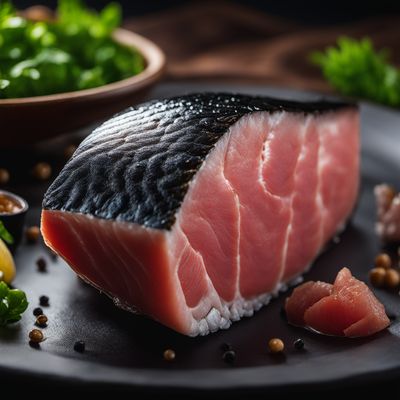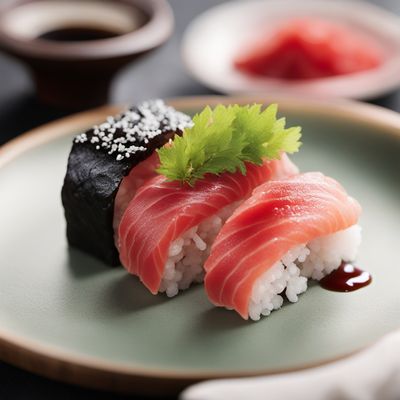
Ingredient
Tuna, bigeye
The Mighty Bigeye Tuna
Bigeye tuna is a large species of tuna with a firm texture, deep red flesh, and a rich, meaty flavor. Its high fat content gives it a buttery taste and makes it ideal for both raw preparations like sushi and sashimi, as well as cooked dishes like grilling or searing. Its robust flavor pairs well with bold seasonings and sauces.
Origins and history
Bigeye tuna is native to tropical and subtropical waters around the world, including the Atlantic, Indian, and Pacific Oceans. It has a long history of being a valuable food source for many cultures, particularly in Japan where it is highly prized for sushi and sashimi. In recent years, overfishing has posed a threat to its population, leading to conservation efforts to protect this magnificent species.
Nutritional information
Bigeye tuna is an excellent source of high-quality protein, omega-3 fatty acids, and essential vitamins and minerals. It is low in saturated fat and calories, making it a nutritious choice for a balanced diet.
Allergens
Some individuals may be allergic to tuna, including bigeye tuna. Allergic reactions can range from mild to severe, so it is important to exercise caution if you have a known allergy.
How to select
When selecting bigeye tuna, look for firm, glossy flesh that is free from any discoloration or strong fishy odor. The eyes should be clear and bright, and the skin should be intact. If purchasing whole, the gills should be bright red, indicating freshness. If buying fillets, choose ones that are moist and have a vibrant color.
Storage recommendations
To maintain its freshness, store bigeye tuna in the coldest part of your refrigerator, ideally between 30°F and 34°F (-1°C to 1°C). Keep it tightly wrapped in plastic or place it in an airtight container to prevent any odors from permeating the flesh. Consume it within 1-2 days of purchase for the best quality.
How to produce
Bigeye tuna is primarily caught in the wild, making it challenging for amateur producers to raise. It requires vast oceanic environments and specialized equipment for commercial production.
Preparation tips
Bigeye tuna can be enjoyed raw in sushi and sashimi, or cooked through various methods such as grilling, searing, or baking. For raw preparations, slice the tuna thinly against the grain to showcase its vibrant color and delicate texture. When cooking, marinate the tuna in flavorful sauces or seasonings to enhance its natural taste. It also pairs well with citrus, soy, ginger, and sesame flavors.
Substitutions
Yellowfin tuna, albacore tuna
Culinary uses
Bigeye tuna is commonly used in sushi, sashimi, poke bowls, ceviche, and grilled tuna steaks. It is also a popular choice for canned tuna due to its rich flavor and meaty texture.
Availability
Bigeye tuna is commonly available in countries with access to deep-sea fishing, such as Japan, the United States, Spain, and Australia.
More ingredients from this category

Bullet tuna
The Speedy Predator

Tuna, yellowfin
"The Jewel of the Sea: Exploring the Delights of Yellowfin Tuna"

Albacore
The Mighty Albacore

Tuna, blackfin
The Ocean's Delicacy: Exploring the Richness of Blackfin Tuna

Tuna, longtail
The Ocean's Swift Hunter

Tuna, skipjack
The Ocean's Bounty

Tuna, bluefin (generic)
The Jewel of the Sea: Exploring the World of Bluefin Tuna
Recipes using Tuna, bigeye » Browse all

Japanese-style Bibimbap
Harmony Bowl: A Japanese Twist on Bibimbap

Tuna Tartare with Citrus Zest and Avocado
Zesty Tuna Delight: A Refreshing Twist on French Tuna Tartare

Akami Nigiri Sushi
Savor the Delicate Harmony: Akami Nigiri Sushi

Syrian-inspired Otoro Nigiri Sushi
Silky Delights: Syrian-inspired Otoro Nigiri Sushi

Otoro Nigiri Sushi
Heavenly Delights: Otoro Nigiri Sushi

Nouvelle Bibimbap
Elevated Korean Delight: Nouvelle Bibimbap

Hong Kong Tuna Bun
Savory Tuna Delight: Hong Kong Style Bun

Japanese-inspired Tapas
Umami Fusion: Japanese-inspired Tapas with a Spanish Twist

Chutoro Nigiri Sushi
Delicate Harmony: Chutoro Nigiri Sushi

Maguro Nigiri Sushi
Ocean Delight Nigiri Sushi

Ukrainian-style Tekkamaki with Beetroot and Dill
Beetroot Delight: Ukrainian-inspired Tekkamaki Rolls

Futomaki Sushi Rolls
Savor the Flavors of Japan with Futomaki Sushi Rolls